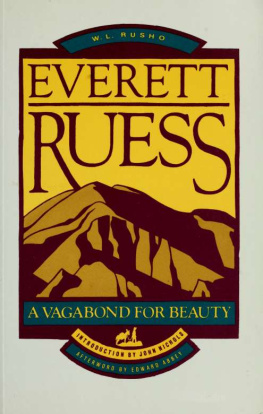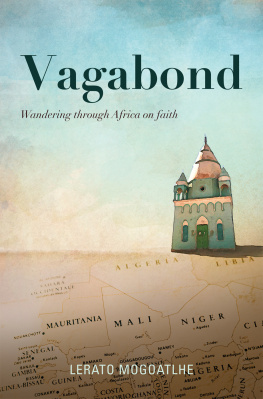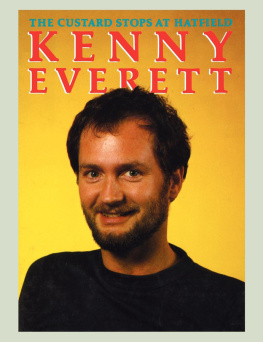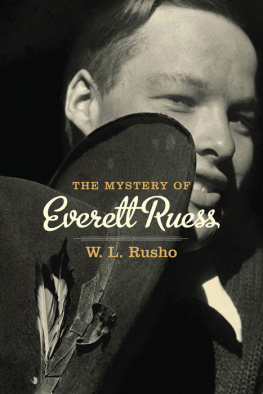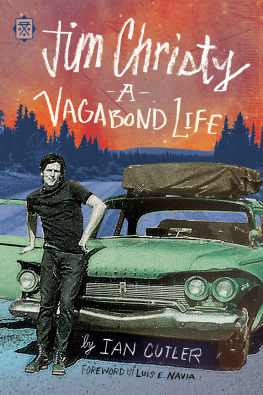W.L. Rusho - Everett Ruess, a vagabond for beauty
Here you can read online W.L. Rusho - Everett Ruess, a vagabond for beauty full text of the book (entire story) in english for free. Download pdf and epub, get meaning, cover and reviews about this ebook. City: Salt Lake City, year: 1983, publisher: Peregrine Smith Books, genre: Non-fiction / History. Description of the work, (preface) as well as reviews are available. Best literature library LitArk.com created for fans of good reading and offers a wide selection of genres:
Romance novel
Science fiction
Adventure
Detective
Science
History
Home and family
Prose
Art
Politics
Computer
Non-fiction
Religion
Business
Children
Humor
Choose a favorite category and find really read worthwhile books. Enjoy immersion in the world of imagination, feel the emotions of the characters or learn something new for yourself, make an fascinating discovery.
- Book:Everett Ruess, a vagabond for beauty
- Author:
- Publisher:Peregrine Smith Books
- Genre:
- Year:1983
- City:Salt Lake City
- Rating:4 / 5
- Favourites:Add to favourites
- Your mark:
- 80
- 1
- 2
- 3
- 4
- 5
Everett Ruess, a vagabond for beauty: summary, description and annotation
We offer to read an annotation, description, summary or preface (depends on what the author of the book "Everett Ruess, a vagabond for beauty" wrote himself). If you haven't found the necessary information about the book — write in the comments, we will try to find it.
Everett Ruess, a vagabond for beauty — read online for free the complete book (whole text) full work
Below is the text of the book, divided by pages. System saving the place of the last page read, allows you to conveniently read the book "Everett Ruess, a vagabond for beauty" online for free, without having to search again every time where you left off. Put a bookmark, and you can go to the page where you finished reading at any time.
Font size:
Interval:
Bookmark:

This book made available by the Internet Archive.






PREFACE
Everett Ruess's story is a half-century old and time has almost obscured it. It is usually a campfire legend or an item of canyon country trivia. A person relating the account can almost always count on his listeners* never having heard Everett's name. The book On Desert Trails with Everett Ruess, first published in 1940, included some of his letters and a few poems. But the book has long been out of print and is rarely seen.
Coincidentally, Gibbs Smith, president and publisher of Peregrine Smith Books, and I had both separately read On Desert Trails. With some detective work, editor Buckley jeppson located Everett's brother, Waldo, in Santa Barbara, California.
Waldo, the only remaining member of the Ruess family, not only had most of the known letters, photographs, and paintings of Everett in his possession, he agreed to make them available for publication. The next two years were full of hard work and discovery. Every one of the hundreds of items either authored by, or written about, Everett Ruess had to be read. All documents were sorted and classified according to their dates, importance, and interest.
Then I entered the picture. I had spent considerable time visiting, writing about, and photographing the northern Arizona/ southern Utah area where Everett did his vagabonding in the early 1930s, so I welcomed the opportunity.
My knowledge of Everett himself was, however, still sketchy when the three of us drove to Escalante, Utah, in September of 1982 to make inquiries. Surprisingly, many people in the village still remembered Everett from his two-week stay there in November of 1934. We then drove southward into the spectacular canyon and cliff country near Hole-in-the-Rock. After a night in a range cabin tucked between towering domes of red sandstone, we rode horseback into the depths of Davis Gulch, where Everett's last camp and his inscriptions were found.
There were other trips to other cities in Utah, Arizona, and Mexico to interview witnesses like Clayborn Lockett, Tad Nichols, Randolph "Pat" Jenks, who had all known Everett. I spent a great deal of time discussing Everett and the country in which he disappeared with Ken Sleight, noted river and canyon country guide, who has investigated Ruess over a period of many years. I took notes, recorded conversations, took photographs, and listened to the lore of the canyon country.
EVERETT RUESS: A VAGABOhJD FOR BEAUTY
Thus the book grew in scope, depth, and significance. I cannot state that nothing more remains to be learned about Everett. Some of his friends from his early years in Los Angeles are undoubtedly still alive, as are people he met in San Francisco in 1933-34. Many of them have not yet been located. Maybe the publication of this book will cause some to come forward with new information which sheds further light. Perhaps Ruess's missing writings, such as his 1934 journals, will surface because of the publication of this book. The publisher and the Ruess family would appreciate the extra information and the study can go on.
Everett Ruess was a highly complex young man with multiple consuming motivations we can only begin to understand. We have hints in his correspondence that he was poorly understood even in his lifetime. That he may have concealed part of his nature even to his close friends and relatives is a possibility subject only to educated guesses. Fortunately, his letters and other writings are so replete with descriptive, introspective detail that from them alone Everett's basic personality and character begin to emerge. To have been able to add color and dimension to this image of the young man who could write so well has itself been a fascinating mission of discovery.
W.L. Rusho Salt Lake City April 1983
INTRODUCTION
JOHN NICHOLS
By the time Everett Ruess disappeared, he had fashioned a magnificent obsession that probably killed him.
His determination to plod alone through the southwestern wilderness was so fierce and arrogant that at times he seemed to be utterly consumed. Eventually, it is probable he lost all understanding of natural scale or human endurance. And along the way that ordinary awareness of danger we human beings carry must also have dissolved from his consciousness.
It is not that the man took leave of his senses, but rather that he was totally enflamed by a wonderful awareness of them. The documentation of his pursuit of enlightenment, as contained in his letters and journals, is the valuable gift of Everett. And it is not necessarily a tragedy that in the end the deserts and canyonlands of Arizona, Utah, and New Mexico proved larger, and more powerful, than his solitary existence could incorporate.
Repeatedly, as this erudite, sometimes penniless romantic wandered behind his burros through impressive and almost uncharted regions during the 1930s, he protested in letters to the outside world: "I have seen almost more beauty than I can bear."
And, repeatedly, he acknowledged, as have so many others, that places like Keet Seel and Kayenta, Escalante and Monument Valley, Navajo Mountain and Skeleton Mesa had "such utter and overpowering beauty as nearly kills a sensitive person by its piercing glory."
At the beginning of his multiple treks into the desert, Ruess had no real idea of exactly what he hoped to accomplish. Toward the end of his recorded wanderings a few years later, that lack of focus no longer mattered. Outsiders probably had no difficulty viewing this out-of-kilter sojourner as a self-indulgent and extravagant oddling overcome by awkward and self-conscious sensibilities. Often his proseand his actionsseem, variously, childish, purple, ludicrous, pretentious, and precious. And yet to Ruess, his life must have come to seem incredibly whole as he wandered over the land, his only purpose to experience weather, distant buttes, rivers... and the mysterious halos that float across desert horizons like the inner fires of unbridled imaginations.
So the landscape, and his simple, painful act of traversing its cruel and beautiful skin, forged in Ruess an extraordinary passion. Ultimately, it was his life that was his greatest work of art, and we ex
EVERETT RUESS: A VAGABOMD FOR BEAUTY
perience it though his letters. At times his writing seems pompous; often it is truly beautiful. Thinking about this eccentric loner confronting the Southwest, one is reminded of F. Scott Fitzgerald's moving words toward the end of The Great Gatsby, that famous eulogy for early explorers when first they arrived at the green uncharted realm of Americahumanity, for the last time in history, face to face with a geography, a continent, an "aesthetic contemplation" commensurate with its capacity for wonder.
Font size:
Interval:
Bookmark:
Similar books «Everett Ruess, a vagabond for beauty»
Look at similar books to Everett Ruess, a vagabond for beauty. We have selected literature similar in name and meaning in the hope of providing readers with more options to find new, interesting, not yet read works.
Discussion, reviews of the book Everett Ruess, a vagabond for beauty and just readers' own opinions. Leave your comments, write what you think about the work, its meaning or the main characters. Specify what exactly you liked and what you didn't like, and why you think so.

